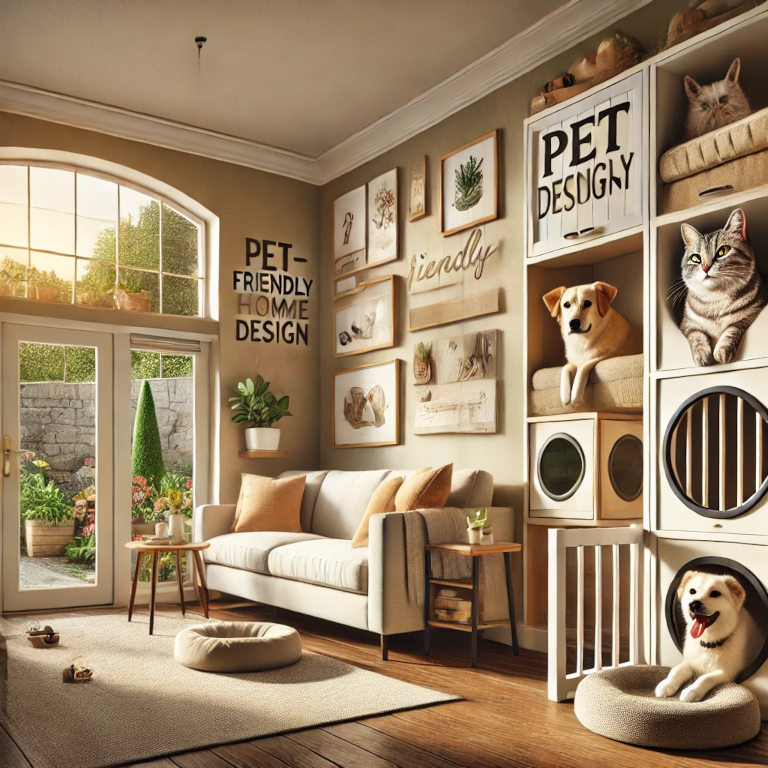Designing a home that accommodates the needs of your pets while maintaining style and functionality can be a rewarding endeavor. As an expert in Home Living, I will guide you through the principles of pet-friendly home designs, offering tips and ideas to create a harmonious living space for both you and your furry friends. This article aims to provide valuable insights into creating a pet-friendly environment that enhances the well-being of your pets and the aesthetics of your home.
Understanding Pet-Friendly Home Design
Pet-friendly home design involves creating a living space that is safe, comfortable, and stimulating for pets. This includes choosing durable materials, incorporating pet-specific features, and ensuring that the home layout accommodates the unique needs of different animals. The key aspects of pet-friendly home design are:
- Durability: Using materials that withstand wear and tear from pets.
- Safety: Creating a safe environment free from hazards.
- Comfort: Ensuring pets have cozy and accessible areas to rest and play.
- Functionality: Integrating pet needs into the overall design without compromising on style.
Key Elements of Pet-Friendly Home Design
1. Flooring Choices: Pets can be tough on floors, so choosing the right flooring material is crucial. Opt for durable, scratch-resistant, and easy-to-clean options such as:
- Hardwood: Select harder wood species like oak or maple, and consider a protective finish.
- Tile: Ceramic or porcelain tiles are highly durable and easy to clean.
- Vinyl: Luxury vinyl flooring is water-resistant, scratch-resistant, and provides a soft surface for pets.
- Laminate: High-quality laminate can mimic the look of wood while offering superior scratch resistance.
2. Pet-Friendly Furniture: Choose furniture that can withstand pet activity and is easy to clean. Consider the following tips:
- Upholstery: Select fabrics like leather or microfiber that are resistant to stains and scratches. Removable and washable slipcovers are also a practical option.
- Pet Beds: Provide comfortable and washable pet beds in various locations around the home. Consider elevated pet beds to keep pets cool and provide better support.
- Protective Covers: Use furniture covers or throws to protect your sofas and chairs from pet hair and dirt.
3. Smart Storage Solutions: Organize pet supplies efficiently to keep your home tidy and functional:
- Built-In Storage: Integrate built-in storage solutions for pet supplies, such as cabinets or drawers specifically designed for leashes, toys, and food.
- Multi-Functional Furniture: Consider furniture pieces that double as storage, such as ottomans or benches with hidden compartments.
4. Safe and Stimulating Outdoor Spaces: Ensure your outdoor areas are secure and enriching for pets:
- Fenced Yard: Install a secure fence to keep pets safe while allowing them to explore freely.
- Pet-Friendly Landscaping: Choose non-toxic plants and avoid using chemicals that could harm pets. Create shaded areas and provide water sources.
- Activity Zones: Designate areas for pet activities, such as a digging zone for dogs or climbing structures for cats.
5. Accessible and Comfortable Spaces: Create accessible and comfortable areas for pets throughout your home:
- Pet Doors: Install pet doors to allow easy access to outdoor spaces.
- Ramps and Stairs: Use ramps or pet stairs to help small or elderly pets access higher areas.
- Window Perches: Provide window perches for cats to enjoy outdoor views and sunlight.
6. Functional and Stylish Pet Areas: Incorporate pet-specific areas into your home design:
- Feeding Stations: Create designated feeding stations with easy-to-clean surfaces. Consider built-in feeding stations in kitchens or mudrooms.
- Litter Box Areas: Design discreet and ventilated areas for litter boxes. Use furniture pieces designed to hide litter boxes while providing easy access for cleaning.
7. Easy Maintenance: Choose materials and designs that make cleaning easier:
- Washable Rugs: Use machine-washable rugs and mats to protect floors and provide comfort for pets.
- Pet-Friendly Paint: Opt for semi-gloss or satin finishes on walls, which are easier to clean and more resistant to stains.
- Vacuum-Friendly Design: Design your home with minimal clutter and easy-to-clean surfaces to simplify regular cleaning tasks.
Tips for Maintaining a Pet-Friendly Home
1. Regular Cleaning: Establish a cleaning routine to manage pet hair, dander, and dirt. Use pet-specific cleaning tools and products to keep your home fresh.
2. Grooming: Regularly groom your pets to reduce shedding and maintain their health. Brush their fur, trim their nails, and clean their ears to prevent messes and discomfort.
3. Training: Train your pets to follow house rules, such as staying off certain furniture or using designated areas for bathroom needs. Positive reinforcement techniques can help reinforce good behavior.
4. Health and Safety: Ensure your home is free from hazards such as toxic plants, small objects that can be swallowed, and exposed wires. Regularly check for potential dangers and make necessary adjustments.
Creating a pet-friendly home design involves thoughtful planning and consideration of your pets’ needs. By choosing durable materials, incorporating pet-specific features, and ensuring safety and comfort, you can create a harmonious living space that benefits both you and your pets. Embrace the principles of pet-friendly design to enhance your home and provide a nurturing environment for your furry companions.






